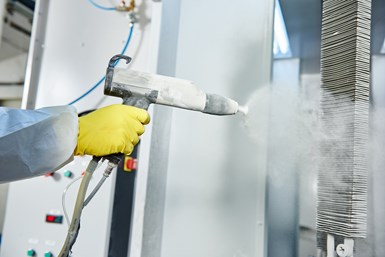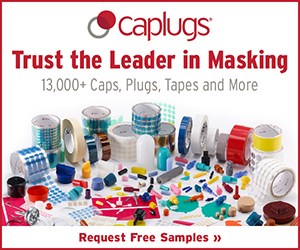Developments and Trends in Powder Coating
New solutions for powder coating centers combine powder preparation, conveyance, dosing and color changes into a fully automated, closed system.
Q: We are looking at converting to a powder coating system for quality issues and wondered, what are the new application trends?

A: On the one hand, powder coating is characterized by ever stricter quality requirements, the trend toward more extensive individualization and increasing cost pressure. This balancing act can only be managed by consistent process optimization.
The use of powdered enamels is one of the most environmentally friendly and resource-conserving processes in the field of industrial coating technology. As a result, powder coatings have established themselves in the past in innumerable applications in a great variety of industry sectors, ranging from architecture, furniture manufacturing, household appliances and the automotive industry to machinery and equipment manufacturing as well as consumer goods. Due to increasing demands regarding coating quality, material and energy consumption, individuality and productivity, coating job shops and companies with in-house painting operations are faced with the challenge of optimizing their processes. Digitalization and the intelligent networking of processes are also becoming more significant.
Manufacturing technology is usually at the center of attention when designing components — surface quality and corrosion protection are often neglected. However, this often causes unnecessary effort and additional costs later on. Special attention should thus be paid to drill holes, undercuts, false edges, narrow gaps, slots, cross-sectional transitions, small transition radii at fillets and the like. In particular, in the case of workpieces made of sheet metal, even minimal rounding of the edges can enhance corrosion protection at these critical areas. Compared to sharp, unworked edges, significantly more coating material adheres to rounded edges after the production of sheet metal parts.
Metal substrates such as steel, galvanized steel and aluminum are cleaned by means of wet chemical processes with cleaning agents that are matched to the material and the contamination. Depending on the type of contamination to be removed, dry processes such as CO2 snow-jet cleaning, as well as plasma and laser cleaning, can be used for precision cleaning. Where the pretreatment of metallic substrates is concerned, the trend toward nanoceramic systems (which are compatible with a variety of metals) is gaining momentum. These alternatives to conventional iron and zinc phosphating offer economic, ecological and process engineering advantages. Achievable corrosion protection is comparable to that provided by zinc phosphating or may even surpass it.
New and further developed powdered enamel systems are doing justice to the stricter requirements for corrosion protection, anti-graffiti, metallic effects, heat reflection, resistance to UV radiation and weathering, low-temperature coatings, scratch resistance or antimicrobial characteristics. Innovative metallic powdered enamels not only make it possible — with just a single layer — to produce a look analogous to a surface coated with liquid paint but also create effects that are visible from all viewing angles. In the meantime, powdered enamel systems are available for dull matte surfaces, which are in popular in architecture, as well as for automotive, sports and furniture applications. They can also provide high levels of gloss stability at various baking temperatures and with different substrate thicknesses.
Thanks to organometallic substances with ionizing effect, antimicrobial powdered enamels are not only lastingly effective against bacteria but also against viruses, fungi and algae. Energy savings and increased throughput due to shortened crosslinking times can be achieved through the use of low-temperature powdered enamel systems. Depending on the formulation and application, these powdered enamels crosslink at of a temperature of 120°C (indoor applications) or 140°C (outdoor applications). Ultrathin powder coatings permit significantly reduced consumption thanks to reduced layer thicknesses.
Powder-in-powder solutions are meeting the increased demands for energy efficiency and corrosion protection, as well as resistance to UV radiation and weathering (for example, components used in construction and agricultural machines, for outdoor use and in architecture). They make coating possible without energy-intensive intermediate crosslinking.
Opportunities for eliminating process steps, while also increasing quality, are offered by the powder in-mold coating process (PIMC). Among other applications, this technology is used to manufacture power and distribution cabinets from sheet molding compound (SMC) (for example, plate-shaped, dough-like molding compounds made of thermosetting reactive resins and glass fibers). The powdered enamel, which has been specially modified for the application, assures excellent resistance to weathering and scratching, high levels of anti-graffiti protection and very good resistance to aggressive cleaning agents and caustic solutions.
The field of systems technology also demands efficient solutions for high-quality results. Job-shop coaters and companies with a broad-based spectrum of components that require coating also expect high levels of flexibility. Manual powder coating booths can be a good solution for offering excellent flexibility with a minimal investment. In addition to good work ergonomics, these booths also provide easy cleaning, good illumination and optimum ventilation. This is supplemented by powder guns which ensure steady powder output and process control for precision powder application, as well as powder savings thanks to application efficiency. Quick color changes are also a must.
New solutions for powder coating centers combine powder preparation, conveyance, dosing and color changes into a fully automated, closed system. The integrated approach makes it possible to achieve increased productivity, while retaining high quality standards and simple operation. Combined with an automated powder coating booth, a powder recovery system and powder guns make it possible to set up a fully automated powder coating system.
Depending on the intended application, automated powder coating booths are equipped with lifting equipment or robots. A dynamic contour laser scanner also contributes to efficient work. The system detects even highly complicated object geometries and guides the powder guns to the right position in order to provide high-quality coating for complex components. The laser scanner accurately acquires object contours. In combination with the associated primary controller with 3D software, the shape of the object is automatically compiled, the coating parameters are adjusted accordingly and the powder gun’s axes are individually positioned. This assures outstanding coating results for complex geometries, even in the case of thin bracing or protrusions, and the need for manual coating is reduced to a minimum.
Intelligent software solutions provide targeted, economical powder consumption and profitable coating in small lot quantities. A new, intuitive and intelligent controller for painting robots makes it possible to set up robots on short notice for coating divergent workpieces or one-piece orders. The innovative solution combines modern robotics with human intuition and flexibility. This eliminates the need for programming effort and the new workpiece is processed on site by an appropriately skilled employee with the help of a manual remote control.
Doris Schulz is with PaintExpo. The next PaintExpo will take place from April 26 to 29, 2022 in Karlsruhe, Germany.
Related Content
Understanding and Managing White Spots on Anodized Aluminum
Having trouble with spotting defects when anodizing? Taj Patel of Techevon LLC offers a helpful overview of the various causes of white spots and potential solutions.
Read MoreCrazing and Cracking in Anodizing
Understanding the differences in cracking and crazing in anodic coatings, and insights for mitigating defects in anodized parts.
Read MoreAdjusting Current and Voltage When Powder Coating
Which manual powder coating gun setting is better to adjust, voltage or current? Jeff Hale of Gema USA discusses when to use different settings on your powder gun to achieve optimal results.
Read MoreHow to Choose Between Sulfate and Chloride-Based Trivalent Chromium
There are several factors to consider when choosing between sulfate and chloride-based baths for trivalent chromium plating. Mark Schario of Columbia Chemical discusses the differences and what platers should keep in mind when evaluating options.
Read MoreRead Next
The 2024 Ford Mustang: All the Colors Available
Although Chevrolet has announced the end of the Camaro and Dodge is offering “Last Call” editions of the Charger and Challenger, the Ford Mustang is launching to its seventh generation.
Read MoreEpisode 42: An Interview with Robin Deal, Hubbard-Hall
Hubbard-Hall wastewater treatment specialist Robin Deal discusses the latest trends in wastewater management.
Read MorePowder Coating 4.0: Smarter, Faster, More Efficient and Connected
New tools reduce cost and waste, lower manufacturing footprint of powder coating operations.
Read More






























